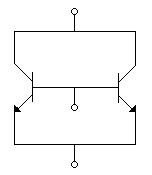Electronics and Communication Engineering - Electronic Devices and Circuits
Exercise : Electronic Devices and Circuits - Section 3
- Electronic Devices and Circuits - Section 1
- Electronic Devices and Circuits - Section 2
- Electronic Devices and Circuits - Section 3
- Electronic Devices and Circuits - Section 4
- Electronic Devices and Circuits - Section 5
- Electronic Devices and Circuits - Section 6
- Electronic Devices and Circuits - Section 7
- Electronic Devices and Circuits - Section 8
- Electronic Devices and Circuits - Section 9
- Electronic Devices and Circuits - Section 10
- Electronic Devices and Circuits - Section 11
- Electronic Devices and Circuits - Section 12
- Electronic Devices and Circuits - Section 13
- Electronic Devices and Circuits - Section 14
- Electronic Devices and Circuits - Section 15
- Electronic Devices and Circuits - Section 16
16.
In which material do conduction and valence bands overlap
Answer: Option
Explanation:
This is the reason for high conductivity of conductors.
17.
For a photoconductor with equal electron and hole mobilities and perfect ohmic contacts at the ends, an increase in illumination results in
Answer: Option
Explanation:
Increase in illumination reduces resistance of a photoconductor.
18.
Discrete transistors T1 and T2 having maximum collector current rating of 0.75 amp are connected in parallel as shown in the figure, this combination is treated as a single transistor to carry a total current of 1 ampere, when biased with self bias circuit. When the circuit is switched on, T1 draws 0.55 amps and T2 draws 0.45 amps. If the supply is kept on continuously, ultimately it is very likely that


Answer: Option
Explanation:
T1 draws 0.55 A and T2 draws 0.45 A, T1 will get more heated and correct increase. Ultimately, I1 = 1A and I2 = 0.
19.
The number of p-n junctions in a semiconductor diode are
Answer: Option
Explanation:
Semiconductor diode has one p-n junction, BJT has two and SCR has three p-n junctions.
20.
Assertion (A): A high junction temperature may destroy a diode.
Reason (R): As temperature increases the reverse saturation current increases.
Answer: Option
Explanation:
Both A and R are correct. The diode is destroyed due to high reverse current.
Quick links
Quantitative Aptitude
Verbal (English)
Reasoning
Programming
Interview
Placement Papers